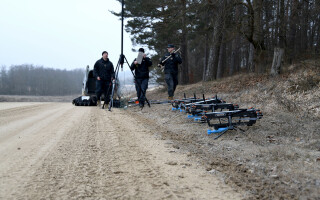Military not deploying to trade shows
StoryMarch 12, 2013
Outside of Special Forces and unmanned trade shows, attendance at industry events has scaled back with DoD budgets.
Do you like crowded convention centers buzzing with tales of new technology and the smell of money being made? If so, you should avoid military conferences/trade shows in the United States. Long lines and packed exhibition aisles don’t exist at these events.
The past six months have been particularly hard on military conference and event planners. AFCEA’s MILCOM 2012 was canceled due to Hurricane Sandy shutting down many East Coast airports, preventing a large number of attendees from traveling to Orlando to attend the event. Other event experiences such as AUSA meetings and AFCEA’s West conference in San Diego experienced last-minute cancellations as the U.S. military services cut back on travel due to budget cuts, anticipation of sequestration, and some say ethical perceptions.
The Association of the U.S. Army (AUSA) Winter Symposium’s last visit to Fort Lauderdale went out with a whimper rather than a roar last month. The annual gathering near the Florida beaches had a much smaller footprint this year. Show management said this year the outside exhibits, those typically featuring Army land vehicles and helicopters, were eliminated due to the decrease in business. (The Army only announced support for the show a couple weeks prior to its start.) While the symposium only attracted 1,400 attendees this year, event officials said they were pleased and said the symposium will happen again next year – just not in Fort Lauderdale. A 2014 location had not yet been selected at the writing of this column, but AUSA officials said they are looking at Raleigh, NC – to be near Ft. Bragg – or military facilities and contractors’ locales in Huntsville, AL. After 2014 they would most likely start a rotation including those two locations and one or two more, according to show officials.
During my previous trips to the Winter Symposium, I found it buzzing with new Army technology with large exhibits and displays from prime contractors such as Lockheed Martin and General Dynamics. You really can’t blame the primes for not going since their customer – the Army – only committed to the show a couple weeks out. Those who did attend apparently were flag officers and staff. A similar atmosphere surrounded the AUSA Annual Meeting, held every October in Washington – typically one of the largest military trade shows/conferences in the U.S. The 2012 event actually shrunk for the first time I can remember.
Many in government and industry credit the travel decline to the DoD’s budget constraints and sequestration fears. However, there also is a perception that events held in places like Sin City, Fort Lauderdale, and other swanky locales are boondoggles. Much of this perception can be traced to the General Services Administration (GSA) scandal in Las Vegas where agency officials reportedly spent nearly a million dollars on an event. However, I fear it will only get worse. Just this morning I read FoxNews.com coverage on a House of Representatives Oversight and Government Reform Committee report that said the DoD spent nearly $89 million on 300 conferences in 2012. No way that gets a positive reception from the public.
The only U.S. events that still seem to create a “have to be there” buzz are those related to Special Forces and unmanned systems such as the Special Operations Forces Industry Conference (SOFIC) and AUVSI’s Unmanned Systems located in Washington. This makes sense as both those application areas will get the bulk of whatever funding is left after budget cuts. I hope this downturn in attendance doesn’t cripple the military trade-show circuit long-term. Many of the events provide education and learning opportunities to military/government attendees as well as chances to meet with industry. Only now the events may have to take on a more modest posture to enable military personnel to get approval to attend. Fewer events will be aligned with warm beaches, Disney World, and the Vegas strip. They will be more strategically located near key military bases.
One group that is generating a lot of buzz at their events – which are located at military bases – is the Future Airborne Capability Environment (FACE) Consortium that is working on a standard to enable software to be reused across multiple avionics platforms. The next event is April 2 at Wright-Patterson Air Force Base (www.opengroup.org/face). For more on FACE and avionics trends, see the Special Report section beginning on page 16 and the Mil Tech Trends section beginning on page 22. Also in this issue, Managing Editor Sharon Hess has redesigned her Defense Tech Wire column to better reflect content from our website – www.mil-embedded.com (see pages 14-15).
John McHale [email protected]





